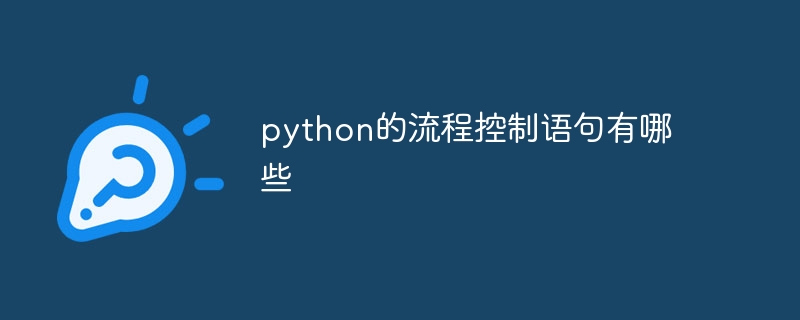
Python's flow control statements include: 1. if statement, which executes different code blocks according to conditions; 2. for loop, used to traverse a sequence or other iterable objects; 3. while loop, when given When the condition is true, a section of code is repeatedly executed; 4. The break statement is used to terminate the current loop and jump out of the entire loop; 5. The continue statement is used to skip the remaining statements of the current loop; 6. The pass statement represents a no-op; 7. The if-elif-else statement executes different code blocks based on multiple conditions.

Operating system for this tutorial: Windows 10 system, Python version 3.11.4, Dell G3 computer.
Python's flow control statements mainly include the following types:
if statement: is used to execute different code blocks based on conditions. For example:
x = 10
if x > 5:
print("x is greater than 5")for loop: is used to traverse a sequence (such as a list or tuple) or other iterable object and execute a piece of code on each element in turn. For example:
for i in range(5):
print(i)while loop: Repeatedly execute a section of code when a given condition is true. For example:
i = 0
while i < 5:
print(i)
i += 1break statement: is used to terminate the current loop and jump out of the entire loop. For example:
for i in range(5):
if i == 3:
break
print(i)continue statement: is used to skip the remaining statements of the current loop and then continue with the next round of loops. For example:
for i in range(5):
if i == 3:
continue
print(i)pass statement: is used to indicate a no-op operation, which has no effect when it is executed. For example:
for i in range(5):
passif-elif-else statement: is used to execute different code blocks based on multiple conditions. For example:
x = 10
if x > 10:
print("x is greater than 10")
elif x == 10:
print("x is equal to 10")
else:
print("x is less than 10")In addition to the process control statements mentioned above, Python also has some other process control tools, including:
List Comprehensions: This is a concise way to create a list in one line of code, applying a loop and conditional statement at the same time. For example:
squares = [x**2 for x in range(10) if x % 2 == 0]
Generator Expressions: Generator expressions are very similar to list comprehensions, but they do not create a new list. Instead, they return a generator object that can be used to generate data on demand. For example:
squares = (x**2 for x in range(10) if x % 2 == 0)
map() function and filter() function: These two functions can be used to apply a function to each element of a sequence or to filter a sequence. For example:
# 使用map()函数将列表中的每个元素平方 squared_list = map(lambda x: x**2, range(10)) # 使用filter()函数过滤出列表中的偶数元素 even_list = filter(lambda x: x % 2 == 0, range(10))
sorted() function: This function can be used to sort a sequence. For example:
numbers = [5, 2, 9, 1, 5, 6] sorted_numbers = sorted(numbers)
Exception handling: Python also supports exception handling, using try/except statements to capture and handle possible errors. For example:
try:
# 尝试执行一些可能会引发异常的代码
x = 1 / 0
except ZeroDivisionError:
# 当出现ZeroDivisionError异常时执行这里的代码
print("Cannot divide by zero!")These flow control tools and statements make Python a flexible and powerful programming language that can be used to solve various types of problems.
The above is the detailed content of What are the flow control statements in python?. For more information, please follow other related articles on the PHP Chinese website!




